“I Like for You to Be Still” — by Stella & Carrot
The Story
We choose the poem “I like for you to be still” by Pablo Neruda as the narration. It is a poem that expresses a man’s passionate love towards a girl that is always silent and seems to exist as a fantasy in a distant past. The man’s love will never get a response, but he still enjoys this feeling.
Link for the poem: https://hellopoetry.com/poem/9922/i-like-for-you-to-be-still/
Link for the Voice-over by Glenn Close: https://www.youtube.com/watch?v=trAGvWlscXg
The Concept
The yellow rose is a visual cue that represents the female, and most of the time, the female figure appears in black&white, as if she lived in a distant past and you couldn’t reach her. We use some aerial shots and open space scenes in nature, for example, the sea and the valley, to convey the passionate love because we think we often get this kind of feeling from nature, the kind of calmness and sublimeness. At 0:50, the water with ripples corresponds to the line “Let me come to be still in your silence” since it is moving but it is still. The next scene showcases a flower blossoming, with its color turning from black-and-white to yellow. The black-and-white color represents the silence of the girl. As “I” approaches the girl in silence, the flower blossoms and becomes colorful as if hearing “my” words. The blossoming process ends with the word “lamp”, which symbolizes the girl’s shiny nature being fully presented. The following scene showcases a pedal falling onto the calm surface of the water, with the ripples representing the poem line “ring”. The pedal symbolizes “simpleness” because it is the basic component of the yellow rose. This scene faded into a deep, starry night. The “constellations”, “star” and “remote and candidate” are animated according to poem lines. “My” eye appears again to announce the speaking protagonist, while the flower being the reflection in “my” eye. The imagined flower exploded into small particles at the word “died”, which corresponds to the unrealistic fantasy. The line “One word then, One smile is enough” is represented through a moving trail of yellow particles, which symbolizes a small part of the exploded flower. These moving particles bring the flower back to life, but the fantasy does not last long and fades again because “it’s not true”.
Ideation Process
At first, we wanted to use the lyrics of “Viva La Vida”, a pop song that depicts the falling of a king, as our narration. However, we found it hard to shoot the scenes that corresponded to the lyrics (i.e. the king’s costume as well as the background of the Middle Ages). We then found an article by Feng Zikai, a Chinese writer as well as a painter. But since the contents were written in Chinese and the article was very long, we found it hard to summarize, translate, and at the same time preserve the original meaning and emotions in the article. We finally decided to use the poem “I Like for You to Be Still” with consideration of the operability.
Collaboration
Collaborative work:
- Topic & Scenes Brainstorming: Stella and I brainstorm our general ideas together. We decide what to shoot and what aesthetic we are going to pursue as well as the editing process.
- Final Video Assembly: We spent a lot of time finding the best way to join the two parts together. For the 00:50 – 00:55 of the film, we decided together to use the water video as a transition between Stella’s clip and mine.
Separate work:
- Filming & Editing: At first, we try to film and edit together, but we can hardly find a time that both of us are available. Therefore, we divide the 01:43 film into two parts. We also developed and modified our original concepts separately, then confirmed with each other about the modifications to the concepts. I’m responsible for the filming and editing from 00:55 to 01:43. For my part, I use Adobe After Effect to create animation and put the animated film back to Premiere Pro for color correction, effects applications, and layering.
- Storyboard: We make two versions of the storyboard. In the first version, we created the storyboard separately, with Stella starting from the beginning and me starting from the end. And I created the second version of the storyboard.
Stella inspired me about the aesthetics style that may help visualize abstract feelings. Before, I always use cute, humorous, and cartoonish visual styles. Such styles generate concrete, direct representations. But in this poem, such a style cannot show the abstract emotions properly. On the other hand, Stella is very good at expressing abstract feelings through filming. I learned a lot about her style through our discussion as well as her part of editing and filming.
Storyboard
First Version
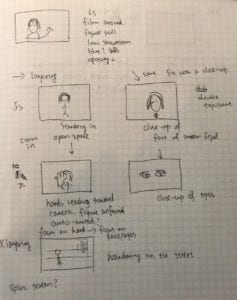
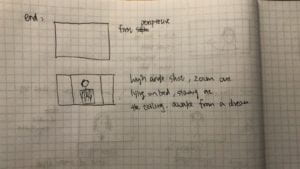
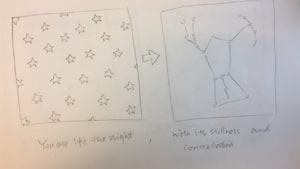
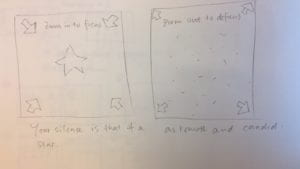
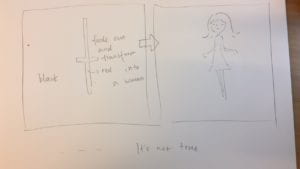
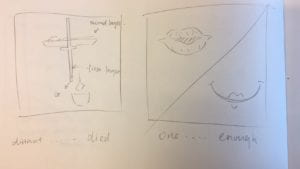
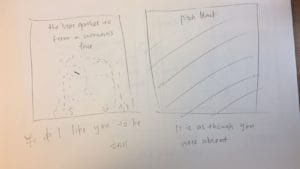
Second Version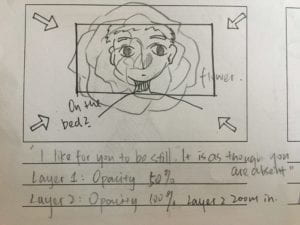

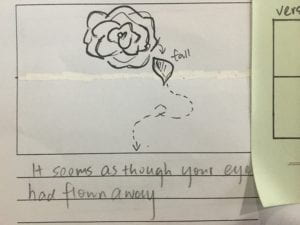
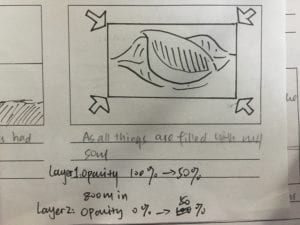
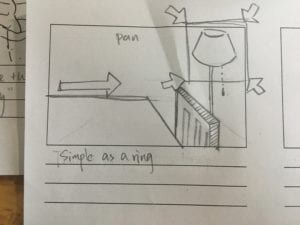
Through creating the storyboard, we agreed on the ideas of shooting and editing, making the execution more efficient.
Filming Process
We decided on the scenes we needed before separately filmed them. For my part of the filming, I used my phone and a stabilizer to film the falling petal. I tried to shoot the human eye, but the resolution is not good enough for scaling, and instead, I use online footage. Stella went to a rosary to shoot the flower scene. She not only filmed the rose but also filmed other clips such as fountains and fallen leaves. But they were not used in our video with considerations of the distractions they may cause. She also came up with the great idea of filming a girl dancing with a rose in hand in the studio and then do the layering.
Editing Process
At first, I want to hand-draw the starry animation and use the panning technique for the last few scenes. However, the aesthetics were too cartoonish. So I learned to create particle systems and animation in Adobe After Effect on Youtube. One thing to be noted is that I develop my ideas and concepts about the animation content through learning the After Effect techniques: I didn’t intend to create the exploded flower and the trail of moving particles at first, but when I went through the tutorials, I found some of the techniques could be utilized to replace our original concepts (showcased in the first version of storyboard). After confirming with Stella, I applied these techniques to the new concepts. In Premiere, I used layering and adjusted opacity and speed to make transitions between scenes smooth and gentle, which correspond to the overall aesthetics of our project.
For Stella’s part, she utilized the split-screen techniques as well as layering in Premiere. She also did a lot of color corrections on the footages she used to make various elements connect to each other. When assembling, we further modified the colors of each scene so that the aesthetics stayed consistent throughout the video.
ScreenShots from Premiere
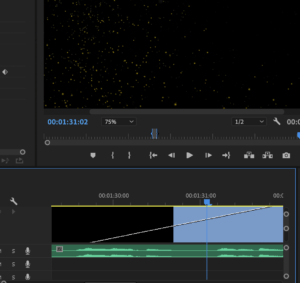
Adjusting Opacity and Speed using the “Show Clip Keyframe”
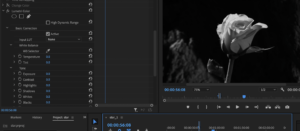 Animate “Saturation” in the effect “Lumetri Color” to make the flower change from black-and-white to yellow
Animate “Saturation” in the effect “Lumetri Color” to make the flower change from black-and-white to yellow
Screenshots from After Effect
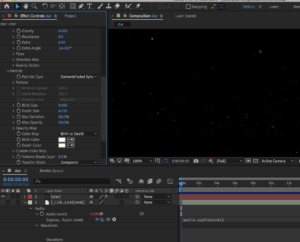
Adjusting parameters in Particle System
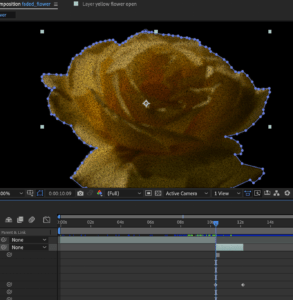
Using the Pen tool to trace the border of the flower
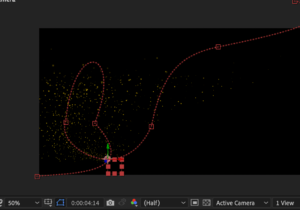
Path creation with the Pen tool

Coding process to make the particles move along the path
Difficulties & Solutions
- Difficulties in finding actors and actresses: The filming was scheduled to be done during the final weeks. Therefore, we couldn’t find the actor and actress for our film: Stella tried to film the dancing shot outdoor at first, but the actress couldn’t afford the time. We then decided to film this part together, with me being the actress, but the weather was really bad and again, we had to abandon this idea. For the original idea of the male’s shot (a man sitting on a chair talking to emptiness), I filmed it in the 2nd-floor lounge and didn’t ask him to change costume because the actor was busy with his study. Therefore, the costume as well as the scene didn’t correspond to the overall aesthetics and feelings of the film. Stella solved the problem by shooting in the studio and using multiple layers to create the setting-sun effect. I shot another scene (pedal falling) to replace the original clip.
- Disagreement on transitions: Stella preferred transitions without “dissolve” effects, which I found a little abrupt. We spent some time deciding whether to use transition effects. In the end, Stella didn’t use transition effects while I used a lot of fade-in and fade-out. But when we put our clips together, it seemed ok to have different transitions in different places.
- Difficulties in assembling the two parts of the video together: Since we divided our video into two parts, we have to assemble them after we finished our separate parts. Stella used a lot of black-and-white scenes, but the flower scenes in my part were always with high saturation, and the two parts seem to be disconnected from each other. We solved this problem by animating the “saturation” parameter in the effect “Lumetri Color” so that the transition from the black-and-white, faded style to the colorful scenes was smoother.
Aesthetics & Results
We use faded and peaceful aesthetics to create the feeling of illusion by using blurry, transparent, and grainy visual effects with multiple layerings and adjustments of opacity. The color is a combination of warm tone and cold tone so that the contrast between the passionate love and the still illusion can be presented. There are few camera movements in the video so that the gentle feelings are more effectively conveyed. In the class critique, we are advised to adjust the color of the flower to make the visual cue more obvious throughout the piece. And it is also mentioned that there are two many elements in the video. Therefore, if we had more time, we may reduce the metaphors we used and make some color adjustments to the flower scenes.